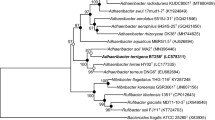Abstract
This work deals with the taxonomic study of orange-pigmented bacteria isolated from permafrost sediments, rice plots, and soils contaminated with wastes from the chemical and salt industries that were assigned to the genus Brevibacterium on the basis of phenotypic characteristics, as well as of some strains described previously as Brevibacterium linens. The study revealed three genomic species, whose members and the type strains of the closest species of Brevibacterium had DNA similarity levels between 24 and 59%. The strains of the genomic species differed from each other and from the known species of Brevibacterium in some physiological and biochemical characteristics, as well as in the sugar and polyol composition of their teichoic acids. The 16S rDNA sequence analysis confirmed the assignment of the environmental isolates to the genus Brevibacterium and showed the phylogenetic distinction of the three genomic species. The results obtained in this study allow three new Brevibacterium species to be described: Brevibacterium antiquum (type strain VKM Ac-2118T = UCM Ac-411T), Brevibacterium aurantiacum (type strain VKM Ac-2111T = NCDO 739T = ATCC 9175T), and Brevibacterium permense (type strain VKM Ac-2280T = UCM Ac-413T).
Similar content being viewed by others
REFERENCES
Collins, M.D., Genus Brevibacterium, The Prokaryotes, Balows, A. et al., Eds., New York: Springer, 1992, vol. 2, pp. 1351–1354.
Collins, M.D., Jones, D., Keddie, R.M., and Sneath, P.H.A., Reclassification of Chromobacterium iodinum (Davis) in a Redefined Genus Brevibacterium (Breed) as Brevibacterium iodinum nom. rev., comb. nov., J. Gen. Microbiol., 1980, vol. 120, pp. 1–10.
Collins, M.D., Farrow, J.A.E., Goodfellow, M., and Minnikin, D.E., Brevibacterium casei sp. nov. and Brevibacterium epidermidis sp. nov., Syst. Appl. Microbiol., 1983, vol. 4, pp. 388–395.
Anderton, W.J. and Wilkinson, S.G., Evidence for the Presence of a New Class of Teichoic Acids in the Cell Wall of Bacterium NCTC9742, J. Gen. Microbiol., 1980, vol. 118, pp. 343–351.
Fiedler, F., Schaffler, M.J., and Stackebrandt, E., Biochemical and Nucleic Acid Hybridization Studies on Brevibacterium linens and Related Strains, Arch. Microbiol., 1981, vol. 129, pp. 85–93.
Fiedler, F. and Bude, A., Occurrence and Chemistry of Cell Wall Teichoic Acids in the Genus Brevibacterium, J. Gen. Microbiol., 1989, vol. 135, pp. 2837–2848.
McBride, M.E., Ellner, K.M., Black, H.S., Clarridge, J.E., and Wolf, J.E., A New Brevibacterium sp. Isolated from Infected Genital Hair of Patients with White Piedra, J. Med. Microbiol., 1993, vol. 39, pp. 255–261.
Pascual, C. and Collins, M.D., Brevibacterium avium sp. nov., Isolated from Poultry, Int. J. Syst. Bacteriol., 1999, vol. 49, pp. 1527–1530.
Pascual, C., Collins, M.D., Funke, G., and Pitcher, D.G., Phenotypic and Genotypic Characterization of Two Brevibacterium Strains from the Human Ear: Description of Brevibacterium otitidis sp. nov., Med. Microbiol. Lett., 1996, vol. 5, pp. 113–123.
Wauters, G., Charlier, J., Janssens, M., and Delmee, M., Brevibacterium paucivorans sp. nov., from Human Clinical Specimens, Int. J. Syst. Evol. Microbiol., 2001, vol. 51, pp. 1703–1707.
Wauters, G., Avesani, V., Laffineur, K., Charlier, J., Janssens, M., Van Bosterhaut, B., and Delmee, M., Brevibacterium lutescens sp. nov., from Human and Environmental Samples, Int. J. Syst. Evol. Microbiol., 2003, vol. 53, pp. 1321–1325.
Kampfer, P., Differentiation of Brevibacterium Species by Electrophoretic Protein Patterns, Syst. Appl. Microbiol., 1994, vol. 17, pp. 533–535.
Zgurskaya, H.I., Evtushenko, L.I., Akimov, V.N., and Kalakoutskii, L.V., Rathayibacter gen. nov., Including the Species Rathayibacter rathayi comb. nov., Rathayibacter tritici comb. nov., Rathayibacter iranicus comb. nov., and Six Strains from Annual Grasses, Int. J. Syst. Bacteriol., 1993, vol. 43, pp. 143–149.
Evtushenko, L.I., Taran, V.V., Akimov, V.N., Kroppenstedt, R.M., Tiedje, J.M., and Stackebrandt, E., Nocardiopsis tropica sp. nov., Nocardiopsis trehalosi sp. nov., nom. rev., and Nocardiopsis dessonvilei subsp. albirubida subsp. nov., comb. nov., Int. J. Syst. Evol. Microbiol., 2000, vol. 50, pp. 73–81.
Streshinskaya, G.M., Shashkov, A.S., Usov, A.I., Evtushenko, L.I., and Naumova, I.B., The Cell Wall Teichoic Acids of Three Actinomycete Genera from the Order Actinomycetales, Biokhimiya, 2002, vol. 67,no. 7, pp. 939–947.
Versalovic, J., Schneider, M., de Bruijn, F.J., and Lupski, J.R., Genomic Fingerprinting of Bacteria Using Repetitive Sequence-based Polymerase Chain Reaction, Methods Cell. Mol. Biol., 1994, vol. 5, pp. 25–40.
Thompson, J.D., Higgins, D.G., and Gibson, T.J., CLUSTAL W: Improving the Sensitivity of Progressive Multiple Sequence Alignment through Sequence Weighting, Position Specific Gap Penalties, and Weight Matrix Choice, Nucleic Acids Res., 1994, vol. 22, pp. 4673–4680.
Jukes, T.H. and Cantor, C.R., Evolution of Protein Molecules, Mammalian Protein Metabolism, Munro, H.N., Ed., New York: Academic, 1969, pp. 21–132.
Van de Peer, Y. and De Wachter, R., TREECON for Windows: A Software Package for the Construction and Drawing of Evolutionary Trees for the Microsoft Windows Environment, Comput. Appl. Biosci., 1994, vol. 10, pp. 569–570.
Marmur, J. and Doty, P., Determination of the Base Composition of Deoxyribonucleic Acid from Its Thermal Denaturation Temperature, J. Mol. Biol., 1962, vol. 5, pp. 109–118.
Meyer, S.A. and Schleifer, K.H., Deoxyribonucleic Acid Reassociation in the Classification of Coagulase-Positive Staphylococci, Arch. Microbiol., 1978, vol. 117, pp. 183–188.
Tijssen, P., Hybridization with Nucleic Acid Probes: Part II. Probe Labeling and Hybridization Techniques, Lab. Techniq. Biochem. Mol. Biol., 1993, vol. 24, pp. 291–406.
Author information
Authors and Affiliations
Rights and permissions
About this article
Cite this article
Gavrish, E.Y., Krauzova, V.I., Potekhina, N.V. et al. Three New Species of Brevibacteria, Brevibacterium antiquum sp. nov., Brevibacterium aurantiacum sp. nov., and Brevibacterium permense sp. nov.. Microbiology 73, 176–183 (2004). https://doi.org/10.1023/B:MICI.0000023986.52066.1e
Issue Date:
DOI: https://doi.org/10.1023/B:MICI.0000023986.52066.1e




